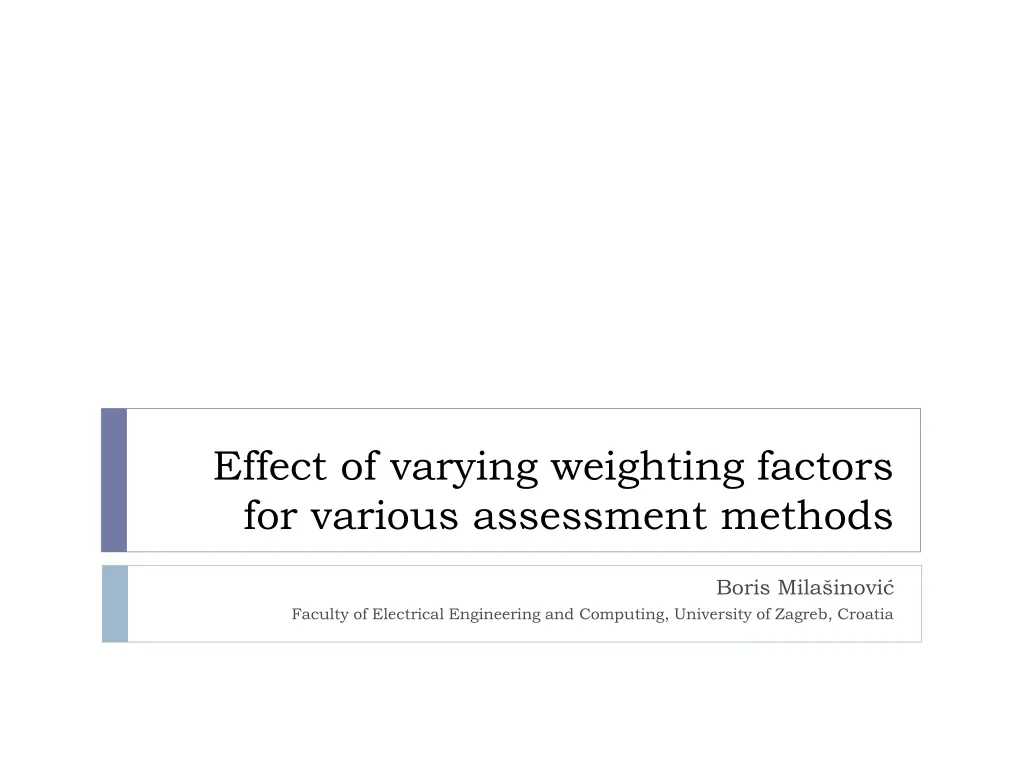
Impact of Varying Weighting Factors on Assessment Methods
Explore the effects of changing weighting factors for different assessment methods in software engineering education, as discussed in a case study. Learn about the motivation, data analysis, and considerations for determining optimal weighting factors to improve evaluation accuracy and student outcomes.
Uploaded on | 2 Views
Download Presentation

Please find below an Image/Link to download the presentation.
The content on the website is provided AS IS for your information and personal use only. It may not be sold, licensed, or shared on other websites without obtaining consent from the author. If you encounter any issues during the download, it is possible that the publisher has removed the file from their server.
You are allowed to download the files provided on this website for personal or commercial use, subject to the condition that they are used lawfully. All files are the property of their respective owners.
The content on the website is provided AS IS for your information and personal use only. It may not be sold, licensed, or shared on other websites without obtaining consent from the author.
E N D
Presentation Transcript
Effect of varying weighting factors for various assessment methods Boris Mila inovi Faculty of Electrical Engineering and Computing, University of Zagreb, Croatia
Motivation Inspired by some previous work Mila inovi - Some experiences using various assessments methods with the emphasis on the automatic evaluation of (programming) assignments, Daad workshop in Durres 2008 Predicting students grades after 1/3 and 2/3 of the semester Mateti and Brki -Analyzing Students' Behavior in a Beginner's Programming Course, Daad workshop in Bansko 2013 Applying data mining techniques on students results Unusual assessment points distribution (25-4-9-2-25-6) and questions how sure we are in our points distribution? what would happen if we change assessments weights? 14th Workshop on Software Engineering Education and Reverse Engineering 24-30 August 2014, Sinaia, Romania
Case study data Development of Software Applications (DSA) The 3rd year of bachelor study Homework: 15 Mid term exam: 20 Classroom activity: 5 Development of Information Systems (DIS) The 1st year of master study Homework: 25 Mid term exam: 20 Classroom activity: 5 Minimum threshold 50% for each activity,except for classroom activity and presence at lectures Data from the last three years Same weights and same semester organization 14th Workshop on Software Engineering Education and Reverse Engineering Quizzes: 30 Final exam: 30 Quizzes: 20 Final exam: 25 Presence at lectures: 5 24-30 August 2014, Sinaia, Romania
How we got those weighting factors? Are 15 30 20 30 and 25 20 20 25 good ? for homework, quizzes, mid-term and final exam,for DSA and DIS respectively How we got them? Estimating effort for a particular assessment Mutually comparing values of assessments taking into account type of assessment (homework or classical test, type of tasks) Rule of the thumb? 14th Workshop on Software Engineering Education and Reverse Engineering 24-30 August 2014, Sinaia, Romania
What would happen if we had changed those factors? Many questions How many grades would change? What would be average change in total points number? What about points distribution? I started analysing current distributions and measure changes for all reasonable combinations where there is no component with more that 50% of points excluding classroom activity and presence at lectures and soon I wanted to change the title of the presentation to How I tortured the data and the data refused to cooperate 14th Workshop on Software Engineering Education and Reverse Engineering 24-30 August 2014, Sinaia, Romania
Problems in points distributions Almost none of assessments is normally distributed It changes slightly (but not too much) if we observe only those above the threshold and if we observe total points distribution Weak correlations between various assessments Significant number of students learn just to pass Many quit after reaching threshold or desired grade Furthermore, correlations change through years without pattern Peaks near the threshold Peaks where the higher grade starts => Nightmare for any prediction 14th Workshop on Software Engineering Education and Reverse Engineering 24-30 August 2014, Sinaia, Romania
Distributions Total number of points (Only those students that have passed) 2013 DSA 2012 2014 2014 DIS 2013 2012
Varying weighting factors of assessments Discarded weights higher than 50 as not reasonable It would assume that one component is valuable than all others together Also such weights yield higher number of changes Combinations with weights from 5 to 50 using 5 as a step 592 combinations for DSA 540 combinations for DIS Measured for each combination (in comparison to the existing weights distribution) Average change in student s total points Number of grades changed Maximum change of a single weight Sum of changes of all weights 14th Workshop on Software Engineering Education and Reverse Engineering 24-30 August 2014, Sinaia, Romania
Results for DSA: Average change in total points X-axis: average change of points for a combination of weighting factors There is no combination (of 592) that change (in average) total number of points more than 5 points (of 100) 2012 2013 2014
Results for DSA: Changes in grades X-axis: number of students that would have different grade using a combination of weighting factors No of students per year: 58 - 75 - 57 In many combinations significant number od students would have different grade but also many combinations produce only minor changes from original grades 2012 2014 2013
Correlations for DSA 2012 Grade Avg MaxDif WDif MaxW 2013 Grade Avg MaxDif WDif MaxW 2013 Grade Avg MaxDif WDif MaxW Grade Avg 0,73 MaxDif 0,73 0,93 WDif 0,68 0,86 0,88 MaxW 0,69 0,86 0,78 0,84 0,73 0,73 0,68 0,69 Grade Grade Number of changed grades Avg Average change of total points MaxDif Highest change of total points WDif Sum of absolute difference of weights MaxW Maximum single change of weights 0,93 0,86 0,86 Avg 0,91 0,88 0,78 MaxDif 0,82 0,91 0,84 WDif 0,79 0,88 0,89 MaxW 0,77 0,86 0,92 0,84 0,91 0,82 0,78 0,77 Grade 0,91 0,88 0,86 Avg 0,78 0,89 0,92 MaxDif 0,7 0,95 0,84 WDif 0,69 0,88 0,87 MaxW 0,69 0,83 0,79 0,84 0,78 0,7 0,69 0,69 0,95 0,88 0,83 0,87 0,79 14th Workshop on Software Engineering Education and Reverse Engineering 24-30 August 2014, Sinaia, 0,84 Romania
Results for DIS: Average change in total points In 2013 & 2014 very similar to those from DSA Little bit higher for year 2012 (up to 8 in average) but only for small number of combinations 2012 2013 2014
Results for ISD: Changes in grades X-axis: number of students that would have different grade using a combination of weighting factors No of students per year 33 27 - 32 Relatively to number of students more changes in grades than for DSA but still many combination that change only few grades 2012 2014 2013
Correlations for DIS 2012 Grade Avg MaxDif WDif MaxW 2013 Grade Avg MaxDif WDif MaxW 2013 Grade Avg MaxDif WDif MaxW Grade Avg 0,74 MaxDif 0,67 0,87 WDif 0,56 0,48 0,5 MaxW 0,47 0,38 0,39 0,86 0,74 0,67 0,56 0,47 Grade Grade Number of changed grades Avg Average change of total points MaxDif Highest change of total points WDif Sum of absolute difference of weights MaxW Maximum single change of weights 0,87 0,48 0,38 Avg 0,73 0,5 0,39 MaxDif 0,64 0,92 0,86 WDif 0,69 0,55 0,56 MaxW 0,55 0,42 0,49 0,86 0,73 0,64 0,69 0,55 Grade 0,92 0,55 0,42 Avg 0,74 0,56 0,49 MaxDif 0,75 0,92 0,86 WDif 0,4 0,54 0,55 MaxW 0,44 0,53 0,51 0,86 0,74 0,75 0,4 0,44 0,92 0,54 0,53 0,55 0,51 0,86
Conclusion Doing comparison to present situation without knowing is the present situation good or bad An idea was to immediately discard combinations that yields distributions that are not normal Cannot be done due original combination is not near normal distribution Do we always have to aim toward normal distribution ? Cannot be done as long as students tend to calculate and have different priorities? Small average changes in points yield not so small changes of grade Peeks - significant number of students learn just to pass, stop after achieving points for a grade or ask for additional point or 2 In some other combination of weights they would act differently as it would directly affect the grades Minor changes in weights (e.g. 5, even 10 in some combinations) almost does not have effect No need to worry if weights are not perfect ? 14th Workshop on Software Engineering Education and Reverse Engineering 24-30 August 2014, Sinaia, Romania






















